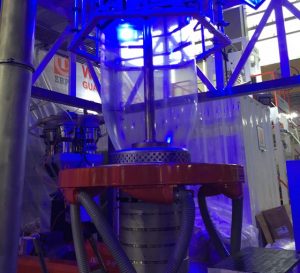PE Film Market Snap-Shot: Fresh Produce, Self-Serve, and Wet-Pack Bags

We’ve reported on stretch film, t-shirt bags, institutional can liners , consumer can liners, and shrink film in previous installments of this blog series, which provide snap shots of the results of 2017 research conducted by market-research firm Mastio & Co., St. Joseph, Mo. on the PE film industry. Here, we take a look at his analysis on the fresh produce, self-serve, and wet-pack bag market.
Mastio clarifies each type of bag accordingly: Fresh produce bags are utilized by growers, distributors, and grocers to package produce for their customers. The bags are sealed and placed on the shelf for consumers. Self-serve bags are on roll dispensers, boxed, or wicketed, and are placed among the fresh fruit and vegetable bins in supermarkets. They are usually perforated and allow consumers to select and package their own produce. Wet-pack bags are usually pulled from a box at the check-out-counter or located near the frozen-food sections of grocery stores. They are used to prevent products such as frozen juice, ice cream, or meats from damaging the carryout bag or other items packaged in paper grocery sacks.
Last year, processors in this film market consumed about 253.8 million lb of PE. With an average annual growth rate (AAGR) of 6.1%, Mastio is projecting PE resin consumption for this market is expected to reach 303.8 million lb by 2020. Future growth can be attributed to companies enhancing the performance of breathable PE films and allowing for packaging to preserve the flavor, appearance, and texture of fruits and vegetables for extended periods of time.
The three most common types of fresh produce bags include side-sealed or side-weld, tubular, and baler bags, according to Mastio. Fresh produce film gauges typically range between 0.25 mil and 8 mils, with 2-3 mils being most typical. Multicolor printing, distinctive lettering, and logos are being utilized on fresh produce bags to appeal to the consumer. Clarity is important for self-serve bags, as grocery store clerks need to easily identify what is packaged in the bags. Clarity, gloss, and toughness are the key requirements for self-serve bags, and they should be easy to open in order to eliminate consumer complaints. The standard gauges for self-serve bags range from 0.4 mil to 3 mils with the most typical gauge being 0.6 mil. Wet-pack bags typically have a gauge range of 0.25 mil to 0.6 mil with 0.4 mil being the most typical gauge.
In 2017, according to the Mastio research, the four largest producers in the fresh produce, self-serve, and wet-pack bag market were Charter NEX Films; Next Generation Films, Inc.; Sigma Plastics Group; and Inteplast Group Ltd. Collectively, these four companies consumed 125.2 million lb of PE, accounting for about representing 49.3% of the market.
Material Trends
According to the Mastio study, PE fresh produce, self-serve and wet-pack bags that are constructed from monolayer film are composed of LLDPE, which provides greater tear and puncture resistance at lower gauges than LDPE. LLDPE resin manufactured with the metallocene single-site catalyst process (mLLDPE) has made great advancements in this market. When utilized in coextrusion or blends, mLLDPE resin allows fresh produce film to breathe while increasing clarity and allowing further downgauging. LLDPE grades such as metallocene, hexene, butene, and octene are sometimes blended with LDPE to enhance strength and flexibility. LDPE resins provide gloss and clarity, facilitate lower heat-sealing temperatures, and aid in film processability and high-output rates. Other resins used in this market include LDPE-homopolymer, LDPE-ethylene vinyl acetate copolymer, HMW-HDPE, MMW-HDPE, PP, and EVOH.
Technology Trends
Fresh produce, self-serve, and wet-pack bags are produced via blown film. They can be either monolayer or multi-layer in construction. Processors who participated in the Mastio study reported producing three- to seven-layer films. Close to 60% of the bags produced for this market are coextruded, Mastio reports.
Processors are also making film that incorporates antioxidant or antimicrobial additives in a controlled-release pattern for film used as internal layers on bags. PE films are designed to allow produce to “breathe” at a rate necessary to maintain the appropriate mix of oxygen, carbon dioxide, and water vapor inside the bag. This type of packaging is referred to as controlled atmospheric packaging. Additionally, food institutions want a clear, nonporous film.
My Two Cents
This is the first PE film market we’ve profiled so far where the top four or five processors dominated the industry in terms of market share. It’s also one where coextrusion technology is being used as a differentiator. Processors that have invested in new technology and are looking to develop new products are more confident about their ability to gain market share.
What also bodes well for this market is that consumers continue to be health conscious and prefer to select their own f